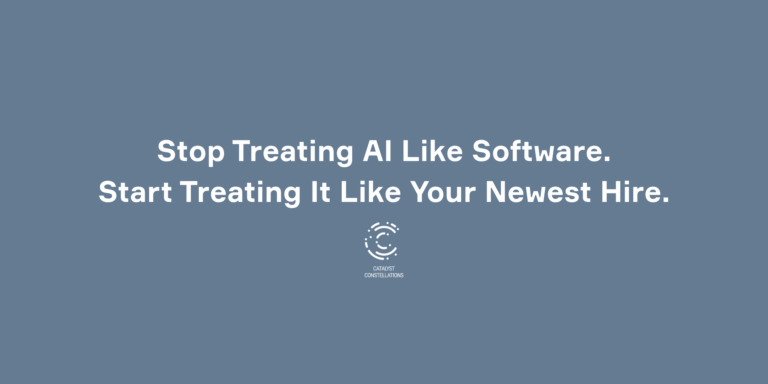Working as a Catalyst and Introvert is a conversation between Cecilie Hoffman and Catalyst Constellations.
How is your work influenced by the fact that you identify as a Catalyst? What challenges do you face?
In 2018 I was hired to re-start the business architecture program at a major eastern region US bank. During the interview process I identified myself as a catalyst and commented that one of my strengths is “activation”. Getting hired is just the first step; the challenges include getting people’s attention, discovering as quickly as possible what would make you trustworthy and believable, and getting a seat at the planning and decision-making tables. Challenges I try to keep to myself are accepting that I often need to work indirectly to gain trust, that is, work on something tangentially related to my true objective, just to be visible and be perceived as delivering good work.
I’m from Silicon Valley, so I am accustomed to working with people / groups / companies that often want to change quickly even when they should be more thoughtful and plan-full. I’ve chosen to work for a traditional company in a highly regulated industry that has a reputation to uphold. It is not in their cultural DNA to make decisions or take action quickly. A challenge I face is remembering that I made this employment choice for a reason, and not feel that I’m inadequate to the challenge when things take longer than I might like.
You’ve talked about being an introvert – have you found anything unique about being an introvert AND a catalyst?
Unfortunately, synonyms for introvert are “shy, reticent” so people incorrectly assume that an introvert is not just shy and reticent but quiet and easily intimidated, too. An introvert is someone who recharges their energy in solitude or in the company of a few trusted individuals. Introvert catalysts draw on the courage of their convictions, they typically exude a depth of confidence that gives others confidence. Introverts develop a laser-like focus on what needs to be done so they don’t waste the time that needs to be invested gaining the trust of people.
You suggested introverts find other introverts and create a “mutual support cohort” – but isn’t that difficult for introverts to do? What steps did you take to make this easier on everyone?
I just joined a new team. In our first in-person meeting I asked, “who else is an introvert?” Three people raised their hands. In a team of eight people, four of us are introverts! We aren’t going to socialize as introverts, we are going to be a safety net for each other, we can feel safe talking to each other on an as-needed basis.
You’ve said, “Be proud that your mind works differently than most other people’s minds”. How have you seen that catalytic mind be a benefit in your work?
There is a saying (of unknown and contentious origin), “Lead, follow, or get out of the way”. In my experience, most people are comfortable being followers, most of the time. There’s nothing wrong with this, it is wonderful to have a clear task to accomplish and feel good about doing the work well. There are moments where some people will take a leadership role, even for a short time, and define the work needs to be done to achieve a goal, and even define the goal to be achieved. Being a catalyst is influencing leaders and followers to coalesce around an objective, to take that first step, to build momentum. Being a catalyst is also helping people realize that their lack of engagement/action is not neutral, it is dragging a boat anchor. Sometimes their mind cannot engage, as a catalyst, I appeal to their heart to care about the others who are affected by the situation. Most people can be reached, it is a matter of finding the right channel. In some cases, the best outcome is to obtain an agreement from an uncommitted person that they will not sabotage the effort.
You’ve said, “Most people want to help, especially when they believe that their life or life in general will improve from the effort. Once you know whether to or how to engage with a person, the catalysis can begin. Otherwise, you have more homework to do.” Do you have any examples of this?
This story may be the first example of my sticking my professional neck out. I was the junior knowledge engineer on two-person software development team. I could see that the model we were building was getting messy. The reason was simple, we discovered a critical piece of knowledge from our SME weeks after we had settled on the object model. We weren’t sure how much the new piece of knowledge would impact the model so instead of revising the design, we tacked on little workaround. Well, that little workaround was getting used more and more; it affected the performance of the application, and worse, it grew like a hairball.
There was a clean solution, a change to the top-level design of the model. The senior person on my team did not want to make any change. I talked to a couple of his peers, showing them the problem and my solution approach. One of the peers admonished me for not just having it out with my teammate, but that peer did listen. I waited, and I’m not known for being patient. About a week later my teammate told me, “go ahead”. My teammate was in his first leadership role, he knew there was a growing problem, and he was afraid to change our first model. As the junior, I was not believable. Seeking out the people he considered believable and influencing them to agree that the risk/benefit of changing the model was favorable, he gained the peer support he needed to make the right decision. Our relationship changed as well, he trusted me more, and, I discovered later, by taking the initiative, I had earned the respect of his peers.
In a different company where I was in a senior single contributor role, a manager decided to take a group of people with similar job functions and call it a center of excellence. We were now a centralized resource –we were anything but excellent. Seeing the level of inconsistency in the work artifacts coming out of the group, I asked my manager to allow me to create and teach a fundamentals class that would baseline the group’s skillset. Another reason for the inconsistent deliverables was the one template that we were supposed to use for everything, even though there were four use models. A hammer is great for nails, not so great when you need a screwdriver, a crescent wrench, or a pair of needle nose pliers. I co-developed the course with a like-minded colleague, and worked with SMEs to design the special-purpose templates. Initially one of the SMEs told me, “They will never adopt this, don’t waste my time.” I kept coming back to him with ideas, asking, “What about this, would this make your life better?”. He eventually relented and shared his own ideas which were much better than mine. Some of the people who needed the course information the most hung back the longest. I think the issue was pride, “I don’t need training.” The committee that reviewed the group’s deliverables cleaned up these stragglers by rejecting their deliverables and telling them that their work needed to meet the new standard. The new, specialized templates also faced resistance, people didn’t want to use them because the content was different. The review committee adopted three of the four templates. The quality of the work artifacts improved, and as did people’s confidence in their work. The course was added to the company’s internal course catalogue. Over a two-year period I taught 240 people coming from a variety of roles. After that, the company realized the importance of training and people in the role were expected to attend reimbursed, professionally-delivered training.
Lastly, is there anything else about working as a catalyst you would want people to know?
Being a catalyst means you are going to be associated, for better or worse, with change. It would be nice if it were always change for the better. Sometimes things have to be allowed to fall apart before you can catalyze the improvement. You may face the difficult decision of “do something” which will prolong the bad situation, or “do nothing”, which will both bring a faster end to the bad situation, and, splash mud on your reputation.
For the privilege of being the go-to person to turbo charge the rate of change, you will collect more than your share of bruises. The bruises fade with time, the stories stick around and get better with the re-telling.
Authors: Cecilie Hoffman and Catalyst Constellations




